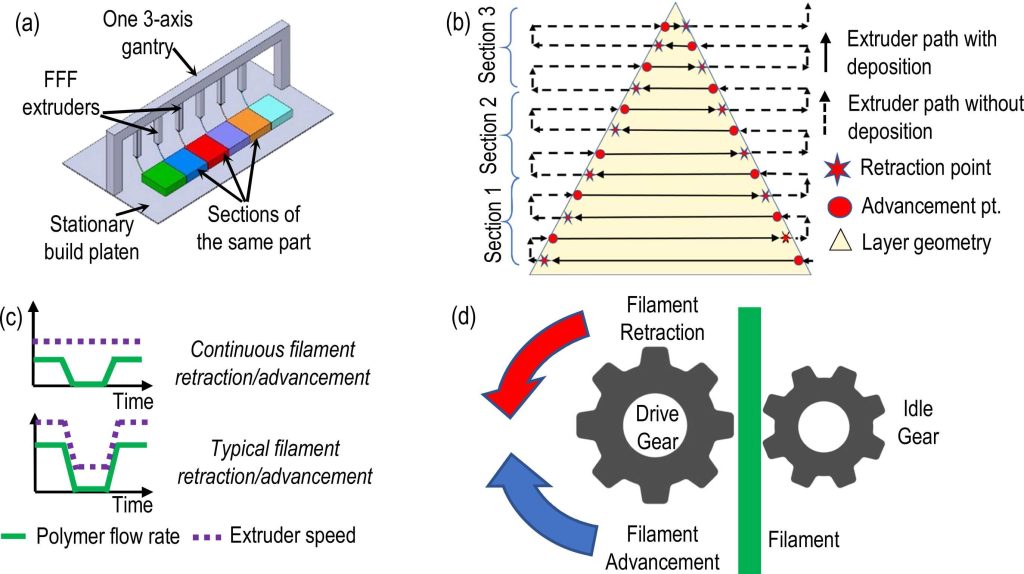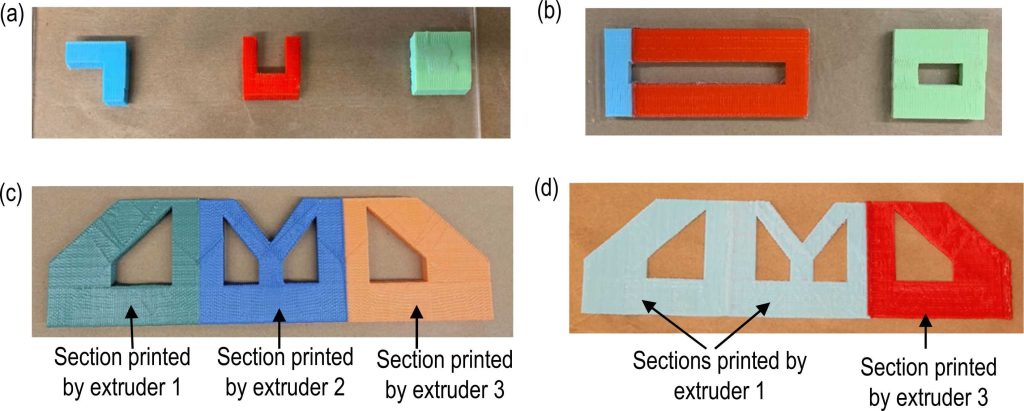Researchers at Rutgers University and the University of Louisville have developed a Fused Filament Fabrication (FFF) system that’s capable of using multiple nozzles to rapidly 3D print different areas of the same part on a single gantry. The 3D printer is double the speed of standard FFF.
Using an in-house developed slicer, the Multiplexed FFF or ‘MF3’ machine is able to deploy two or more printheads concurrently without needing additional gantries to control them individually. In doing so, the team says the MF3 could enable the creation of irregular builds, larger contiguous objects, and multiple distinct smaller parts at over twice the resolution and speed of comparative technologies.
“MF3 will change how thermoplastic printing is done,” says the study’s lead author Jeremy Cleeman. “We have more tests to run to understand the strength and geometric potential of the parts we can make, but as long as those elements are there, we believe this could be a game changer for the industry.”

Industrial FFF 3D printing’s tradeoff
According to the researchers, FFF continues to show potential as a cheaper and better-suited alternative to 3D printing large parts than powder or vat-based technologies. With the likes of Titan Robotics gaining market traction with its pellet-loaded large-format Atlas 3D printers, those familiar with FFF will know the process is already being scaled.
Oak Ridge National Laboratory’s research into Big Area Additive Manufacturing (BAAM) has also given rise to a high flow-rate extruder and large nozzle-based approach, to upping FFF’s print speed. The technology uses a screw-based gantry-mounted extruder to melt and extrude pellets through a nozzle at flow rates of 3,000–8,000 mm3/s, with 5-8 mm-wide roads designed to facilitate faster flow.
However, the team says that matching this high throughput with the resolution needed to achieve fine features continues to prove difficult. While increasing road size (i.e., the size of extruded material beads) to raise throughput results in poor geometric fidelity, reducing road size to achieve high fidelity limits the volume of parts that can be produced.
One way that manufacturers have previously attempted to overcome this tradeoff is by overprinting the part and machining excess material away, but this can be a costly and time-consuming task. Another approach that continues to gain traction is Independent Dual Extrusion (IDEX) technology, a process in which multiple nozzles are used to print different sections of the same part simultaneously.
Such techniques, in which multiple extruders are mounted onto a single gantry, enable the production of twin parts in tandem on the same machine. That said, while the technology is marketed by the likes of FlashForge and Raise3D, the researchers say it’s currently limited to periodic geometries. The team also claims that using one gantry per extruder only makes two printheads viable in IDEX setups.

Multiplexed Fused Filament Fabrication
To overcome the perceived drawbacks of existing FFF technologies, the researchers have come up with their own system, composed of three off-the-shelf extruders on a single three-axis cartesian gantry. Unlike those of current IDEX machines, the MF3’s printheads are able to simultaneously create distinct sections of parts thanks to a selective deposition approach.
The team’s technique is made possible by a custom slicer, which is designed to optimize the movements of their machine’s gantry arms, and determine whether or not nozzles should be activated. In practice, this sees the software precisely control the direction and speed of the printer’s stepper motors in a way that allows the filament to be advanced or retracted into the extruder’s liquefiers independently.
Given that each nozzle’s speed isn’t dependent on whether they deposit material, the unit can print parts continuously while avoiding any potential overlap or collisions. The MF3’s concurrent deposition capabilities also enable the creation of parts at a higher resolution and throughput than single-extruder systems, as well as multi-material builds.
In fact, during testing, the machine proved capable of producing parts with 2.5-4 times the resolution of BAAM, and with the incorporation of further nozzles, the team says it could be significantly quicker too. Further experimentation also saw the researchers use their toolpath strategy to concurrently 3D print both large and small parts on the same bed in a way that was estimated to halve their lead times.
Moving forwards, the engineers believe the throughput advantage of MF3 over single-nozzle printing will prove to be greater for larger batch sizes. Thus it could soon allow users to “overcome the reach-driven geometric limitations” of existing technologies and “realize new economies of scale and productivity.”

Advancing high-speed FFF 3D printing
FFF continues to be the subject of significant research into improving its speed and performance. In the past, Titan Robotics has worked with Autodesk to develop a five-printhead Cronus 3D printer with similar goals to the MF3. When unveiled in 2016, the system proved capable of using multiple extruders to simultaneously print an object, however, little has been heard about it on the development front since.
More recently, in February 2021, 3D Systems revealed that it was working with Jabil to launch a high throughput Roadrunner 3D printer. Equipped with the ability to print high-temperature filaments, the system is designed to act as the base of its High Speed Fusion (HSF) platform, and target the automotive and aerospace sectors.
Elsewhere, researchers at the University of Nantes have set out to investigate heat transfer and adhesion during FFF 3D printing. By quantifying the heat exchanges that take place in the process, the researchers attempted to identify the optimal set of print parameters, and maximize the mechanical properties of 3D printed parts.
The researchers’ findings are detailed in their paper titled “Scalable, flexible and resilient parallelization of fused filament fabrication: Breaking endemic tradeoffs in material extrusion additive manufacturing,” which was co-authored by Jerem Cleeman Alex Bogut, Brijesh Mangrolia, Adeline Ripberger, Kunal Kate, Qingze Zou and Rajiv Malhotra.
To stay up to date with the latest 3D printing news, don’t forget to subscribe to the 3D Printing Industry newsletter or follow us on Twitter or liking our page on Facebook.
For a deeper dive into additive manufacturing, you can now subscribe to our Youtube channel, featuring discussion, debriefs, and shots of 3D printing in-action.
Are you looking for a job in the additive manufacturing industry? Visit 3D Printing Jobs for a selection of roles in the industry.
Featured image shows a diagram indicating how the MF3 operates. Image via Rutgers University and the University of Louisville.



